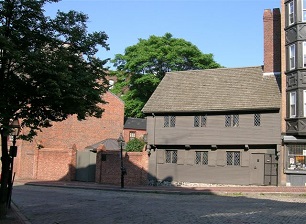Who the Heck is Robert Howard? And Why Should We Care?
By Michael Maler, Interpretive Staff, Paul Revere House
As I stand in the great hall in a seventeenth century timber-frame house in Boston’s North End, welcoming visitors to the Robert Howard House, a look of bewilderment washes over their faces. A hush falls over the crowd. I pause for a moment and wait…and then after a few more moments…the inevitable happens. Someone in the crowd breaks the silence by mustering up the courage to ask the obvious question, “Who is Robert Howard?”

I am indeed standing in the Paul Revere House, so my explanation clarifying that Robert Howard was the first occupant of 19 North Square, ninety years before Paul Revere purchased the home in 1770, and fifty-five years before the famed Midnight Rider was even born, is met with a sigh of relief. And, as importantly—a chuckle.
The ice has been broken, and off we go. The stage has been set to talk about the interpretation of the great hall; the seventeenth century architecture, furniture, and lifestyle that characterized Boston during the Howard occupancy, but has little if anything to do with Paul Revere. But here’s the catch: it’s not me doing most of the talking; it’s the visitors.
I’ve given them Robert Howard’s name, but have offered no other clues as to who he was. Donning them with the title of “history detectives,” I encourage them to come up with the answer themselves by looking around the room and selecting objects or architectural features that draw their attention. Any threshold of fear or anxiety is removed by a simple phrase of encouragement, “You can’t go wrong.”
The methodology here might be characterized as mildly Socratic, but visitors never fail to start calling out the furniture, the (prop) food on the table, the maps on the walls, and the host of other decorative objects that the curator has strategically placed throughout the room. Suddenly and seamlessly, the objects have ceased to be just “objects in a museum” and have instead become “objects of engagement.” They are all clues useful in aiding the visitors in their sleuthing (bolstered with occasional prompting) to determine who exactly Robert Howard was, ultimately arriving at the conclusion that he was a wealthy shipping merchant who amassed his fortune through the trade of tobacco, rum, molasses, and enslaved people. Not only does this newly gained insight paint a very different—and arguably more inclusively accurate—picture of this historic site beyond the Revere occupancy, but also allows visitors to be active participants in the process, experiencing the house and its history on their own terms.
This tactic is not meant to diminish or overshadow the historic importance of Paul Revere—nor the many merchants, maritime sailors, or immigrant families who also made their home at 19 North Square over the past 340 years—but instead, add to and shed new light on it. Though Paul Revere is the most famous occupant of the historic home, Robert Howard matters, too, because through him, a broader, more inclusive picture of the Paul Revere House is painted for each and every visitor, prompting and providing an accessible and relatable platform for discussions about the all-important topics that are so relevant to visitors today.
I would venture to surmise that every historic property has its own supporting cast of characters hidden in the walls—perhaps historical, perhaps fictional, literary, or even in the form of a story, legend, or architectural detail—that have the latent ability to transform the site’s interpretation from good to great; and perhaps even extraordinarily sublime and unexpected. So if historic sites are looking to launch reinvented, invigorating, and relatable engagement opportunities for visitors, it may not be as daunting an undertaking as it seems. A good place to start might be to ponder the elementarily simple question: “Who is your Robert Howard?”